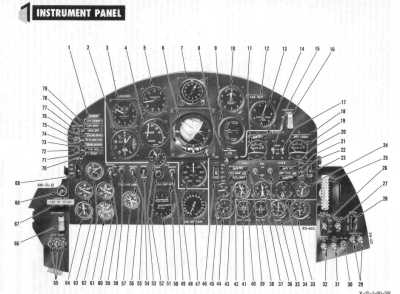X-15 pilot
report, part 2:
X-15 Cockpit Check
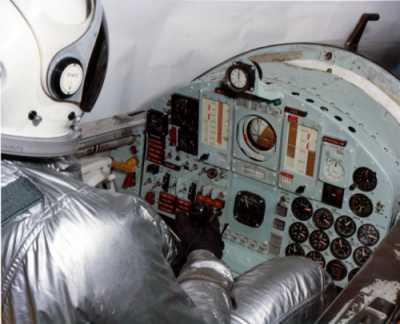
This is a cozy place, don't mess with it if you're claustrophobic.
Admittedly it has just a bit more room than a sailplane cockpit, but
there's LOTS of stuff in it and you can't see much when the canopy is
closed. You get two windows barely larger than slits to peer out of --
the rest is utterly metallic and opaque.
One of the nice touches on top is a head brace that folds downward in
front of you.That makes deceleration at reentry a fair bit easier to
handle. 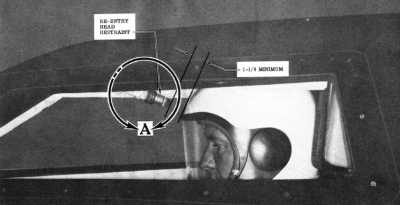 Another
necessary nicety is that the windows are double glazed. In early
flights the X-15 pumped Heated gaseous nitrogen between the panels
keeps them from icing over. This wasn't entirely trouble-free, so it
wasn't long before the nitrogen gap was replaced by a transparent
electrical heating element.
Another
necessary nicety is that the windows are double glazed. In early
flights the X-15 pumped Heated gaseous nitrogen between the panels
keeps them from icing over. This wasn't entirely trouble-free, so it
wasn't long before the nitrogen gap was replaced by a transparent
electrical heating element.
The cockpit is unpressurized below 35,000 feet, but it's air
conditioned. Above 35K it's pressurized to 3.5 psi by nitrogen. Your
pressure suit gets another nitrogen feed to keep it at 3.6 psi.
The ejection seat is almost an airplane itself. If you need it,
it'll unfold
fins, put you in a nice attitude, 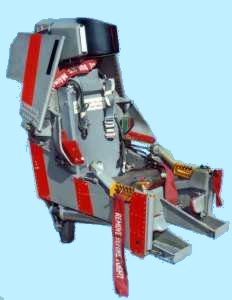 escort you to low
altitude, then blow pieces of itself away and deploy your chute.
According to the manual, it will "permit safe pilot ejection up to Mach
4.0, in any attitude, and at any altitude up to 120,000 feet". You get
your choice about how much to trust those limits, such an ejection has
never been done.
escort you to low
altitude, then blow pieces of itself away and deploy your chute.
According to the manual, it will "permit safe pilot ejection up to Mach
4.0, in any attitude, and at any altitude up to 120,000 feet". You get
your choice about how much to trust those limits, such an ejection has
never been done.
Seat diagram: medium
scale
large scale
Once settled in the seat, you're looking at about 130 odd gages,
switches, lights, and controls of assorted descriptions.
First, there's a conventional center stick and rudder pedals.
There's also
a console stick at your right hand for use when G loads make it
difficult to use the center stick. Both are mechanically coupled
together and to a system of bell cranks that sum their inputs with
those from the Stability Augmentation System (SAS).
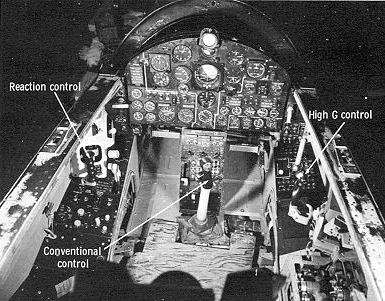
A horizontal stabilizer position indicator is located on the cockpit
wall next to the console stick. This is a must-check item before
dropping
from the B-52 carrier aircraft and before beginning reentry.
 Flight control diagram
Flight control diagram
A third stick, for the ballistic control system, is at your left hand.
When the ballistic control rockets are armed, you can:
- Move it left or right to control yaw
- Rotate it to control roll by firing wing thrusters
- Move it up or down to control pitch
Other ballistic inputs come from the Reaction Augmentation System
(RAS), which is the no-air equivalent of the SAS.
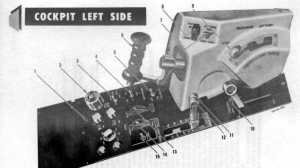
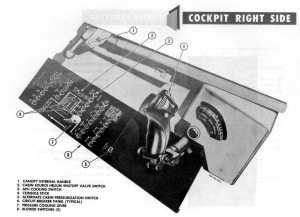
The same left-side panel houses the speed brake lever and the
throttle. The throttle allows a choice of "off" or any thrust setting
between 50% and 100%. In the early days it could go down to 30%, but
the XLR-99 rocket motor was prone to flickering out when it was
developing only a measly 4 1/2
tons of thrust.
The main instrument panel is divided into three sections: Engine
instruments on the lower left, APU's on the lower right, and flight
instruments at top center. Both engine and APU sections are mainly an
assortment of pressure gages, temperature gages, fire warning lights,
and sundry switches.
The most prominent flight instrument is a big attitude indicator,
planted squarely in the middle. It looks fairly ordinary, but it's
accurate throughout 360 degrees of rotation around any axis you care to
name.
Scanning clockwise around the attitude indicator, starting just
below it,
the flight instruments are...
- Roll rate indicator, calibrated to 200 degrees per second. The
X-15 is pretty agile in roll, but you need to limit the rate to no more
than 50 degrees per second in some conditions for the sake of stability.
- Altimeter: Looks ordinary, but it has a cutout that unveils
warning strips when you're dangerously low -- under 16,000 feet.
- Airspeed: Usable from 100 to 1,000 knots; has a vernier drum to
show speed to 1 knot anywhere in this range.
- Angle of Attack: Reads -10 to +40 degrees. Stay below +20
degrees to avoid stability problems, or +17 1/2 after jettisoning the
ventral.
- Accelerometer: Reads +12 to -5 G's. Allowed load factor ranges
from +3/-2 G with a full load of propellant to +7/-3 G at burnout
weight.
- Azimuth indicator: A high class compass. Like the attitude
indicator and the next few instruments, its reference is the
gyro-stabilized platform in the "Inertial All-Attitude Flight Data
System".
- Inertial height (altimeter): Shows altitudes up to 1 million
feet. The little hand reads hundreds of thousands, the big hand reads
tens of
thousands.
- Inertial speed: Calibrated for any speed up to 7,000 feet per
second. That translates to 4,150 knots or 4,773 mph.
- Inertial vertical velocity: Reads up to 1,000 feet per second
(60,000 fpm) in increments of 100 fps.
We'll skip the remaining cockpit clutter, only because it's generally
less amusing, though some of it will appear in the test flight.
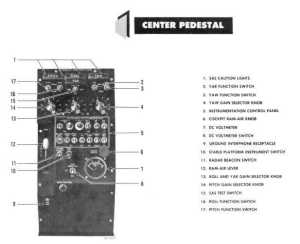
This pilot report is split into these four parts:
1. X-15 General
Description & Walkaround
2. X-15 Cockpit Check
3. X-15
Flight: Heading Out to Launch
4. X-15
Flight: Flying the Mission and Returning
Related to all four sections:
Photo credits
and pointers to related resources
.
Send questions and comments on the SierraFoot X-15 pages to Paul Raveling.
Return to X-15
pilot report root page X-15
home page SierraFoot
site home page
 Another
necessary nicety is that the windows are double glazed. In early
flights the X-15 pumped Heated gaseous nitrogen between the panels
keeps them from icing over. This wasn't entirely trouble-free, so it
wasn't long before the nitrogen gap was replaced by a transparent
electrical heating element.
Another
necessary nicety is that the windows are double glazed. In early
flights the X-15 pumped Heated gaseous nitrogen between the panels
keeps them from icing over. This wasn't entirely trouble-free, so it
wasn't long before the nitrogen gap was replaced by a transparent
electrical heating element. 






